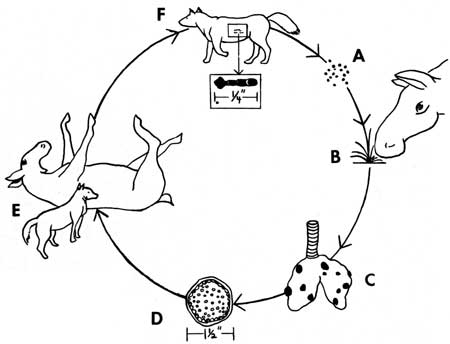Echinococcus granulosus
A Parasitic Tapeworm
Parasitic Lifestyle
E. granulosus, like all other cestodes, is considered a parasite. A parasite is an organism that lives in or on another organism, the host, which it obtains nutrients from while doing harm to the host organism. This particular species requires two hosts to complete its life cycle, a definitive host and an intermediate host. Which host the parasite is in is dependent on the reproductive stage of the organism.
A definitive host is one in which the parasite reaches maturity. Moreover, if the parasite can reproduce sexually, it occurs in this host. For E. granulosus this is where proglottid formation and fertilization occurs. Possible definitive hosts for E. granulosus include:
- Dog
-
Wolf
(i.e. Grey Wolf-Canis lupus)
-Coyote
-Dingo
-Hyena
-Lion
(i.e. African Lion-Panthera leo)
An intermediate host is one that only houses the parasite for a short time in order for the parasite to complete a certain part of its life cycle. For E. granulosus, the intermediate host is one in which the hooked embryo hatches and burrows into the small intestine of the host organism to gain access to the bloodstream. Then, the organism travels to one of many optional organs where hydatid cyst formation begins. Possible intermediate hosts for E. granulosus include:
-Sheep
(i.e. Big Horn Sheep-Ovis canadensis)
-Cow
(i.e. Domestic Cow-Bos taurus)
-Deer
(i.e.
White Tailed Deer-Odocoileus virginianus)
-Reindeer
-Moose
-Humans
The cysts produced are passed back to the definitive host
after it consumes the infected organs of the intermediate
host. The infection of organs in
intermediate host can cause a disease known as
echinococcosis or cystic hydatid disease.
